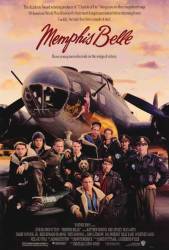Corrected entry: When the crews head out to their aircraft, the ground crews are just finishing "bombing-up" and preparing the planes. In reality, these jobs were begun while the aircrews were still in bed, and would be long finished by the time they arrived at their planes.
Corrected entry: The whole crew of the Memphis Belle are shown having breakfast in the same mess hall. In fact, officers and sergeants messed in separate halls.
Correction: Army air crews had no distinction between officers and enlisted - how many combat mess halls do you think were open at 0300? Air crews operated under a different set of rules. Ground crews had a separate mess.
Corrected entry: The movie features a bomber flown by a crew who are all on their first mission. This never happened. The USAAF (and the RAF) always sent 'first timers' with experienced crew members on their first few flights. It would have been highly unusual to find a bomber with two crew members on their first flight together, let alone all seven.
Correction: Read "A higher call" by Adam Makos, though the entire crew of "Ye Olde Pub" had trained they were all new to combat on their first mission in 1943.
Corrected entry: At the beginning when the planes are coming back, and the last one crashes, slow the playback to slow motion, and you can see the two port engines are missing propellers...one on the inner engine, and two on the outer. Just a few seconds later, those same two engines have all their respective props, but bent back.
Correction: The rules of this site are very clear - if you have to use slow motion to spot it, it isn't a mistake.
Corrected entry: The U.S fighters that escort the B-17s are P-51D Mustangs that have to turn back early due to lack of fuel. In 1943, the bombers would have had P-47 Thunderbolts as escort as the P-51D did not enter service until 1944. The Mustang could also fly all the way to the target and back due to its longer range.
Correction: This statement is somewhat correct. Actually, at the time the Belle historically completed her 25th mission, the escort fighters were British Spitfires, piloted by British pilots. The producers of the film publicly acknowledged this change, stating that they felt American audiences would have been distracted by the usage of British fighters in that scene.
Corrected entry: When the badly damaged Memphis Belle finally lands, the crew disembark and several of them light cigarettes. Not a chance. Anyone smoking within a few hundred yards of a WW2 bomber would have been arrested on the spot - if they were lucky enough to survive the experience. Those planes were flying fuel tanks, and they had lots left sloshing about after a mission. A damaged bomber was especially vulnerable. In fact, crews were forbidden to take smoking materials, matches or lighters on a mission.
Correction: Actually there are several scenes in William Wyler's 1944 film where aircrew are seen smoking next to the aircraft: once before take-off and 1-2 times on return. An injured crewman is attended to before being carried to an ambulance: "A transfusion right in the plane. This gunner is too weak to be moved. New life-giving blood flows into his veins ...". And then a lighted cigarette is placed between his lips and he smiles briefly.
Corrected entry: When they arrive over the target, they find it covered by cloud, and Dennis makes the near-suicidal decision to go around for another run. Bombing missions were briefed for primary, secondary and tertiary targets, plus targets of opportunity; if the primary was inaccessible, the procedure was to abandon it and try the secondary, and so on. The leader of a mission would only go around for a second attempt if there was no possibility of hitting it on later missions (e.g. some of the bombing missions carried out in preparation for D-Day were no-return engagements).
Correction: Although it is correct that usually they were briefed with secondary targets, there were actually a few instances where crews had to go around on a second or even a third bomb run over the same target. In the mission to Stuttgart on Sept 6, 1943 Col R. Travis took the entire group around to bomb on three runs which exhausted the fuel supply of many of the planes and caused many bombardiers to just drop out of frustration. This is well described in the book To Kingdom Come.
Corrected entry: Everytime the gun crews call out attacking fighters, they identify them as (Focke-Wulf) 190's. Only two such aircraft appear in the movie. The rest of the German fighters are Messerchmitt Bf109's.
Correction: During the fighter attacks it is consistently stated by the crew that the incoming fighters are "One-oh-nines". Their voices are strangled and distorted by the oxygen masks but still clear enough.
Corrected entry: In a couple of scenes one of the crew is shown taking photographs indoors with a box camera. As no flash was used and there wouldnt have been any high speed film for that type of camera, they wouldnt have come out.
Correction: And since we never see the photograph it may well have been underexposed and useless, so this is not a film mistake but a character mistake.






Correction: Due to the high number of missions which were cancelled at the last minute due to weather, ground crews often would leave the loading of bombs to the very last minute, to stop them having to unload them again after a last minute cancellation due to cloud cover. This is especially realistic as the mission in the movie is delayed for this reason. Source - "a real good war" by Sam Halpert.